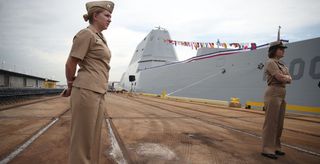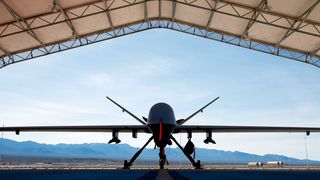Executive summary
The United States is facing multiple challenges to sustaining its military-technological edge in the Indo-Pacific:
- The proliferation of advanced missiles, submarines, satellites and other technology has raised the costs and risks for the United States in a regional conflict.
- Access to advanced technology and innovation has spread, raising the importance of the private sector in maintaining military superiority but also generating new centres of technological progress.
- The United States’ current defence strategy and capabilities are increasingly economically unsustainable, and its defence budget is stagnating due to political polarisation in Congress.
The Third Offset is a set of strategies that aims to bolster US conventional military power by mobilising innovation, new technologies and institutional reform:
- The United States is placing ‘bets’ on a series of new technologies, from artificial intelligence to hypersonic weapons, that will allow its military to project force in contested environments.
- Some of these technologies will, in theory, allow for more economically sustainable military operations and capabilities.
- Reforming US defence institutions to prioritise innovation, and seeking ways to take advantage of new technologies in the private sector, are attempts to embed and sustain US military advantage.
The direction of the Third Offset, and its success or failure, should inform Australia’s strategic outlook. Canberra should seek to expand engagement with the Third Offset, particularly through the following institutional aspects:
- A United States-Australia Defence Technology Workshop should be established to generate new ideas around Indo-Pacific technological trends, investment and new military concepts.
- Canberra should explore the possibility of hosting, or jointly funding, an international Defence Innovation Unit Experimental Office, providing strategic coordination on technological developments, resourcing and opportunities for Australian defence firms.
- Australia needs to expand its engagement with the United States on the testing, exercises and simulations that will form new Third Offset military concepts.
Introduction
The United States’ military-technological advantage, an aspect of its strategic power since the end of the Cold War, is eroding. As China invests heavily in its military and high-end research sector, the superiority of US military forces is less guaranteed than it has been in the recent past. The proliferation of advanced missile technology, submarines, satellites and cyber weapons has raised the costs and risks for the United States in a conflict in Asia. Major competition over emerging technologies is now taking place between the United States and China, and the centre of gravity may be beginning to shift from Silicon Valley to Shenzhen. Sustaining the United States’ military and strategic position with current technologies is straining the Pentagon’s budget, calling into question the United States’ ongoing ability to deter and defeat competitors.
The Third Offset represents an effort by Washington to find means of sustaining its military-technological advantage in this new era of great power competition. Launched by the US Department of Defense in 2014, the Third Offset is premised on the recognition of three trends: that rising competition is emerging between the United States and China; that the technological innovation Washington needs to compete has largely shifted from government labs to the private sector; and that the United States needs to find an affordable way to maintain deterrence and stability. As new technologies and their integration into the military are the centrepieces of this new competition, finding economical ways to leverage research and development for national security goals lies at the heart of Washington’s strategy.
For Australia, the Third Offset’s success or failure will have profound implications for the United States’ future military posture in the Indo-Pacific.
This report depicts the Third Offset as a set of strategies that began under President Barack Obama and are being continued by Donald Trump’s administration.1 The first strategy involves placing ‘bets’ on current and future technologies that will, in theory, allow the US military to maintain its ability to project power into contested environments. A second strategy is to develop new technologies like artificial intelligence, high-powered lasers and unmanned systems that will permit the United States to economically compete with great powers and simultaneously maintain its global military posture. The third strategy consists of reforming US strategic and defence technology institutions to build a focus on innovation, take advantage of private sector developments, and sustain the United States’ military advantage in the long-term.
The Pentagon is largely continuing with these strategies under the leadership of Secretary of Defense James Mattis, although the label “Third Offset” appears to have been dropped from official lexicon. The Offset is perceived as a solution to matching the US defence budget with US strategic ambitions. At the same time, however, it places an additional fiscal burden on the Pentagon, particularly in the short-term, to develop costly new technologies and shift them into production. Ongoing instability in the US defence budget in coming years will thus be a challenge to the Third Offset’s ultimate success.2
For Australia, the Third Offset’s success or failure will have profound implications for the United States’ future military posture in the Indo-Pacific. Whether the United States can sustain its military advantage vis-à-vis China will inform Australia’s national security outlook, the make-up of the Australian Defence Force based on the principle of interoperability with the United States, and Australia’s own defence industry policy. Canberra should seek greater opportunities to coordinate and collaborate with Washington on emerging technologies, including by exploring the co-funding of new innovative defence procurement organisations. As emerging technologies are developed into military platforms, Australia should focus on increasing the range of simulations and exercises it conducts with the United States. Australia has unique geographical advantages that may allow it to act as convenor for exercises and experimentation between allies and partners with Third Offset capabilities.
Lessons from the First and Second Offsets
During the Cold War, the United States embarked on two offset strategies to bolster its position vis-à-vis the Soviet Union. Both took advantage of new technologies to address the operational problem of deterring a numerically superior force and the strategic problem of making deterrence economically sustainable. The fiscal imperative to reduce the costs of strategic competition encouraged bipartisan political support across the US government in both instances.3 The First and Second Offsets hold lessons for the Third insofar as they implemented changes to the structure of the US defence bureaucracy, integrated civilian and military industries, and re-evaluated the role of technology in military affairs.

The First Offset
The First Offset, which began during the Eisenhower administration, sought to build an advantage over numerically superior Soviet forces in Europe through upgrading the role of nuclear weapons. Under the 1955 New Look strategy, Eisenhower aimed to reduce the economic and manpower burden on US forces, and maintain a credible deterrent against Soviet aggression, by investing in strategic and tactical nuclear weapons. The logic was sound: as the United States had a technological advantage in nuclear weapons, by pioneering nuclear doctrines like “massive retaliation” Washington could successfully deter a conventionally superior adversary. Nuclear weapons were a relatively inexpensive way to offset Soviet conventional power. More expensive elements, like the US Navy’s first ballistic missile submarines and the Air Force’s Strategic Air Command, built on existing platforms that had already started to mature during the Second World War.4 Together, these capabilities allowed the United States to attain ‘strategic asymmetry’ with the Soviet Union, meaning that Washington could retaliate to aggression at a time and place of its choosing, strengthening its ability to deter a Soviet attack.5
The Second Offset
The Second Offset, undertaken in the 1970s and 1980s, replaced this reliance on nuclear weapons with new technologies that increased the effectiveness of the United States' conventional military forces. As the Soviet Union had caught up to the United States in the nuclear domain, the Second Offset aimed to develop a new competitive advantage by placing many ‘small bets’ on technologies that began to emerge in the 1970s. These included: networked computing, precision navigation and timing, stealth, and new intelligence, surveillance and reconnaissance (ISR) platforms.6 Like advances in emerging technologies today, these bets were made on the back of major breakthroughs in non-defence research and development that were occurring in Silicon Valley and elsewhere.7 Once again, there was an underlining economic rationale for the Second Offset: if, at the conventional level, a web of new technologies and operational concepts could obviate the need for a costly tit-for-tat arms race against the Soviet Union’s quantitatively superior forces, then deterrence could be sustained at an affordable cost.8
After years of development, simulation, and exercises, these technologies came together to form US precision strike capabilities. This required military services to adopt a “combined arms warfare” approach that integrated sensors, intelligence, and precision munitions into a “reconnaissance-strike complex”.9 At its core, this ‘networked warfare’ concept was about increasing the effectiveness of existing US forces through improving real-time tactical awareness, ordinance guidance, and supporting infrastructure enabling the deployment of force-multipliers. While these capabilities were never used on the battlefields of Europe, as originally intended, they were demonstrated to great effect in the First Gulf War against the mechanised forces of Saddam Hussein. Precision strike and networked warfare cemented US military dominance in the post-Cold War era and still forms the basis of modern military organisation and doctrine today.
Three historical lessons for the Third Offset
These past offsets yield three important lessons for the Third Offset. First, while there was recognition at the time that emerging technologies would be important to warfare, there was not a clear idea about how these would fit together in an operational military concept.10 On the contrary, it took years of investment and training to develop new capabilities, like precision munitions, and the tactics to use them, much of which was undertaken without any certainty of success.11
Second, the Second Offset was explicitly linked to maintaining strategic stability. By bolstering the United States’ qualitative lead over the Soviet Union in the conventional domain, it was thought that Washington would be able to deter a regional attack with a technologically-superior conventional strike.12 This, in turn, would reduce US reliance on nuclear weapons – a product of the First Offset – thereby making its deterrent threats more credible in the eyes of its adversaries.13 Relying on conventional capabilities, rather than nuclear escalation, would also contribute to a more stable strategic balance.
Third, new technology was only part of the equation. One of the underappreciated aspects of the success of the Second Offset was that organisational changes within the Pentagon and armed services helped facilitate the effectiveness of new technological capabilities. For instance, the Goldwater-Nichols Reform Act in 1986 provided for better integration and ‘jointness’ among the services, creating the environment for networked warfare to succeed. The launch of the Defense Mapping Agency in 1972 and US Space Command in 1982 allowed the ISR data from new sensors to be effectively collected and analysed. Similarly, the switch to an all-volunteer force in 1973 brought higher quality personnel to the military, making it “better situated to integrate and employ the new technologies available”.14

Problems for the Third Offset to solve
Just as the First and Second Offsets sought to address the military balance with the Soviet Union, the Third Offset aims to address a return of great power competition and erosion in the United States’ military edge. Three broad dynamics are undermining US power. First, the technologies the United States pioneered during the Second Offset are now being used by its competitors to limit US freedom of action. Second, growing competition in strategic technologies, innovation, and civil-military integration is eroding the United States’ historic technological advantage. Finally, the burgeoning cost of American military capabilities are making its strategic lead more difficult to sustain.
China’s anti-access challenge
The United States is grappling with the proliferation of precision munitions and the systems that enable their use among China, Russia, and other competitors. Following the United States’ effective employment of precision strike weapons, particularly in the First Gulf War, these countries have invested heavily in developing similar capabilities.15 But instead of using these capabilities to project force, they have adapted them into “anti-access and area-denial” (A2/AD) strategies that aim to prevent others from operating in, or gaining access to, a region or theatre.16 In the Indo-Pacific, China is deploying large numbers of conventional ballistic missiles along its coastline in an A2/AD strategy designed to challenge the United States’ ability to project power at acceptable levels of cost and risk.17
China’s A2/AD strategy has been primarily employed along the “First Island Chain”, a string of islands stretching from the Japanese archipelago to Taiwan, the Philippines, Brunei and Malaysia.18 But the reach of China’s conventional ballistic missiles is expanding. Increasingly, new longer-range missiles, like the DF-26, and other assets are extending the range of China’s A2/AD strategy to US forces stationed in Guam and elsewhere along the “Second Island Chain.”19 This dynamic has serious implications for Beijing’s ability to establish spheres of influence through “grey zone” activities, like island-building in the South China Sea, enacted under the cover of A2/AD strategies.20 China’s A2/AD strategies may blunt the effectiveness of US forward deployed forces in a potential conflict. This could lead allies and partners to question the United States’ ability to deliver on alliance guarantees and other commitments without escalating in a crisis, impacting in turn Washington’s credibility.
Emerging strategic technology competition
US military technological advantage is no longer assured. As access to advanced scientific research and technological innovation has increased, geostrategic competition in these advances has followed. Many new technologies, like artificial intelligence (AI), biotechnology and quantum computing, will be the basis of future warfare. If mastered first, they could enable strategic advantage. Many of these advances are occurring in the private sector as opposed to government labs. Recognising these developments, China has instituted significant reforms in the People’s Liberation Army (PLA) and throughout its defence industrial base. Over the past several years, for example, the PLA has improved its adaptability and internal organisation to take advantage of new technologies.21 Its stated aim is to develop the ability to fight and win “local wars under informationised conditions”, meaning that its goal is to win regional conflicts with a peer competitor like the United States.22 Over the next five to ten years, the PLA is expected to begin transferring systems under prototype to production in “domains of emerging military rivalry” including “outer space, near space, cyber space and under water”.23
US military technological advantage is no longer assured. As access to advanced scientific research and technological innovation has increased, geostrategic competition in these advances has followed.
Beijing has also instituted nationwide ‘Made in China’ plans in artificial intelligence, quantum computing, robotics and advanced manufacturing, with the goal of becoming a global leader in each industry over the next several decades.24 China is reforming its approach to defence innovation and research along US lines, recently standing up an agency modelled on the Pentagon’s Defense Advanced Research Projects Agency (DARPA), and has made further integration of its defence and civilian industries a priority.25 These projects capitalise on China’s growing R&D and manufacturing base, which allows it to assimilate new technology at a faster pace.26 Underlying these domestic efforts has been expanding overseas investment in universities, start-ups and emerging technology sectors, particularly in the West, reflecting a growing appetite across China for access to ‘dual-use’ (military and civilian) technologies.27 Incentivising foreign-trained engineers, researchers, and scientists to return to China has also been a focus.28 Alongside its extensive cyber-enabled economic espionage, these trends suggest that China is becoming a formidable competitor for the United States in the realm of emerging defence-related technologies.
The growing cost of the United States’ military lead
The United States is also struggling to balance Chinese power in an economically sustainable way. First, existing US forces are unable to adequately defend themselves in a cost-effective way against the large number of missiles deployed in Chinese A2/AD strategies. The United States has traditionally invested in expensive missile defences designed to protect its power-projection forces against a handful of ballistic or cruise missiles from a rogue state actor, not against the vast arsenal of missiles that China would likely use in a conflict. The “salvo competition” that would ensue between the United States and China – essentially, a numerical contest between missiles and the systems that are intended to defend against them – is not economically viable for the United States to win.29 For example, while the cost of Chinese cruise missiles range from US$1-3 million each, a salvo of 32 missiles could defeat the entire magazine of missile defence interceptors on a US$2 billion Arleigh Burke destroyer – potentially costing China less than US$100 million to neutralise the US ship.30 The destroyer’s entire salvo of missile interceptors would have cost an additional US$300 million.31 There are similarly unsustainable ratios for the cost of THAAD interceptors and medium-range ballistic missiles, as well as far less costly weapons like unmanned drones.32
Second, Washington is likely to continue to face severe defence budget caps that will hamper its ability to compete with China on a ‘platform-for-platform’ basis. Indeed, the US defence budget is already straining under low spending increases and a growing number of competing priorities, including efforts to increase ship numbers, modernise the air force, begin army procurement programs, and bolster military readiness.33 Other priorities, such as nuclear modernisation, will also require new resources from a stagnating budget.34 As China’s economy and defence budget continue to grow, and as Washington attempts to maintain its current force posture and strategic priorities, the Pentagon must find economically sustainable models for great power competition.

The technology of the Third Offset
To meet the United States’ future strategic challenges, the Third Offset attempts to harness emerging technologies, a culture of innovation, and institutional reform. Its technological requirements were informed by a Long Range Research and Development Plan which brought together senior officials, academics, and industry representatives to identify critical emerging technologies for warfighting and US competitive advantages in defence-orientated research. It is clear from subsequent official statements that Third Offset technologies include new ‘software’, such as artificial intelligence, data analytics and cyber capabilities, and ‘hardware’, such as high powered lasers, unmanned systems and advanced engines among others.35 Some of these technologies will lead to more integrated ‘joint’ warfare across multiple domains, as well as new military operational concepts.36
Software
Broadly, ‘software’ such as artificial intelligence, data science and cyber capabilities are critical technologies for the Third Offset. These will be the ‘enablers’ of the strategy in a similar way that ISR and GPS data were for the Second Offset. Software and algorithms permit increasingly integrated operations between human and unmanned systems, faster response times, and aid the management of large amounts of data, theoretically providing the human decision-maker with the best information.37 More and more, ‘software’ is also allowing unmanned systems to operate independently.38 Artificial intelligence, in particular, has been consistently highlighted, with former Deputy Secretary of Defense Bob Work labelling human-machine collaboration the “coin of the realm” or the central organising element of the strategy.39
Human-machine collaboration, fuelled by AI, will facilitate better decision-making in battle.40 For instance, as new threats to naval vessels increase – such as, expendable unmanned systems, advanced cruise missiles and hypersonic vehicles – so will the number of potential ways to defend against them, with high-powered lasers and electronic counter-measures being particularly promising.41 Managing the massive amount of information generated by these systems, and deciding how to act in a compressed time period, will require delegation and automation to machines.42
Human-machine collaboration, fuelled by AI, will facilitate better decision-making in battle.
Third Offset software is also being applied throughout the Pentagon. For example, the recently established Algorithmic Warfare Cross-Functional Team, or Project Maven,43 consolidates several defence intelligence initiatives that apply machine learning and algorithmic solutions to sorting, utilising, and analysing vast amounts of intelligence data.44 Its first task has reportedly been to employ AI to analyse the huge volumes of video data collected by unmanned systems for counter-terrorism operations.45 While intelligence analysis is its “logical starting point”, Maven is expected to expand its work into areas like logistics, communications, situational awareness, and management.46
Hardware
The Third Offset also involves ‘hardware’ elements that aim to improve the cost-effectiveness of US forces and enhance American power projection. During testimony on the Pentagon’s FY2016 budget request, then Secretary of Defense Ashton Carter listed “high-speed strike weapons, advanced aeronautics, rail guns and high energy lasers” as priority areas.47 Other officials have stressed robotics, high performance computing, advanced energy storage and electronic warfare systems.48
High-energy lasers are particularly critical. While laser systems have been of interest to the Pentagon for decades, recent advances in material science, batteries and the switch from chemical to solid-state designs have allowed them to be miniaturised, paving the way for anti-missile defence applications.49 For example, the Navy installed the Laser Weapon System, a 30-kilowat solid-state high-energy laser, on the USS Ponce in 2014 and cleared it for use in self-defence situations.50 As solid-state lasers are electrically powered, they can be continually fired while their ship is generating electricity, dramatically lowering per use cost.51 This system could significantly improve the survivability of vessels against Chinese cruise missiles and other projectiles, making it cost effective to defend against salvo attacks.
Hypersonic missiles are also key to the Third Offset. Using either “scramjet” or “boost-glide” technologies, many hypersonic weapons are highly manoeuvrable and can travel between 5,000 and 25,000 kilometres per hour.52 At these speeds, hypersonic missiles would be able to penetrate modern air defence networks, offering a credible counter to Chinese A2/AD networks and allowing the United States to project power into denied or contested environments.53
Bringing it together: Jointness and autonomy
These and other Third Offset technologies are driving the creation of new operational concepts. Above all, these will enable the US military to boost its capacity for ‘joint’ warfare – the combined unity of effort of different branches of the military – and harness the effect of autonomous systems.54
One practical example is the Joint Interagency Combined Space Operations Centre (JICSPOC), established in 2015, which Work has labelled as the first “operational and organisational construct of the Third Offset Strategy”.55 The JICSPOC aims to coordinate the military and intelligence communities’ satellite operations through a single control centre, including assessments of threats and responses in the event of a conflict.56 It serves as the central point for wargaming, simulation and experimentation on joint-warfare in space, using AI to collate all the information required for “space situational awareness”.57 DARPA has also plugged into the JICSPOC by designing a “virtual space warfare lab” that will test new space operational concepts in response to Chinese advances in anti-satellite capabilities.58
Third Offset technology is also driving autonomous operations. For instance, there is a push to shift some capabilities away from networks with “vulnerable data-links” to ones that are independent and entirely powered by AI and unmanned systems.59 This would make US forces more effective in situations where networks are unreliable or under assault by electronic, cyber and space attack.60 Recent work by DARPA on exploring new concepts and technologies that replicate GPS without relying on satellites could shift the United States away from its vulnerable space architecture;61 research on tactical versions of these systems is occurring in the services.62
The Third Offset as institutional reform
The Third Offset is as much about the institutions powering it as it is about technology. New offices, agencies, and organisations are being established to drive investments, repurpose existing capabilities to buy time for longer-term research, and shift the Pentagon’s thinking around innovation and technology. At least four institutions are part of this process, but new initiatives also include university research institutes, rapid acquisition cells, and reforms to the Pentagon’s procurement programs.63
Strategic Capabilities Office
The Strategic Capabilities Office (SCO), established in 2012, is focused on the operational problems the Third Offset is trying to tackle.64 Instead of developing new technologies, the SCO works with the military to find innovative uses for existing capabilities to enhance deterrence and warfighting now while longer-term bets come to fruition. Will Roper, the inaugural head of SCO, views the office as “buying-time” for the rest of Defense, by “wringing out all the dregs of the things that we have”.65
For instance, SCO has been working on a “cross-domain capability” for the Army Tactical Missile System that will transform the surface-to-surface missile system into a platform for projecting power from coastal locations up to “300 kilometres into the maritime domain”.66 This will allow the system, initially designed to fire on land targets, to also target assets at sea. This capability will contribute to operational concepts that involve the multiple-domains and will complicate competitor defence planning.
Other SCO projects include turning the B-52 strategic bomber into an “arsenal plane” capable of carrying high volumes of munitions that can be remotely trained on a target by forward deployed stealth aircraft.67 This would allow stealth aircraft with a higher chance of surviving in a high-threat environment to harness the firepower of the larger B-52s, giving both a role in a counter-A2/AD strategy. The office is also working on building autonomous naval vessels and repurposing existing munitions for new uses. For example, a relatively simple software upgrade has turned the Navy’s SM-6 missile from a surface-to-air platform into a dual-capable surface-to-surface missile, helping to improve the odds for US forces in a salvo competition. SCO programs have resulted in some early successes and have started laying the ground work for simulations and exercises that will form the basis of a multi-domain operational concept.68
Defense Advanced Research Projects Agency
Housed within the Department of Defense since 1958, DARPA is playing a key long-term role in the Third Offset strategy. DARPA is independent of the tactical and operational needs of individual services. Instead, it invests in and coordinates research aimed at preventing “technological surprise”. Its programs can range from fundamental mathematics and physics to advanced computing and AI. Programs usually take place over decades, with frequent turnover in managers to “generate totally new classes of transformational technologies”.69 While SCO is working on ways to adapt current technologies to contemporary challenges, DARPA is “experimenting” with the most advanced technologies available and “developing them at the same time” for a 20-year horizon.70
Strictly speaking, DARPA’s role is separate to the Third Offset. But Pentagon officials have described it as working on the elements of a strategy that will provide a “sustained advantage” across multiple technological areas. According to DARPA Director Arati Prabhakar, the Third Offset’s goal differs from the “static advantage” of the Second Offset because it requires “built-in evolutionary capacities” to handle ongoing technological advances and upgrades that carry momentum.71 Other Defense officials have echoed this view, saying that long-term competition is about integrating new technologies into “warfare more intelligently and more quickly” than competitors and on an ongoing basis.72

DARPA officials have emphasised that the integration of civilian technology into Defense is only part of the equation. In addition, combining civilian technologies with specific military advances can provide “unique advantages” relevant to the Third Offset.73 One such example is gallium nitride transistors which are used in radar, communication, and electronic warfare technologies.74 DARPA recently combined this commercial transistor technology with a material that enhances its thermal properties, potentially decreasing the size of the transistors by a factor of three and vastly improving performance.75 Early versions of these transistors are already being used in Third Offset programs, like the Next Generation Jammer, providing improved capability to counter the radars and other sensors in A2/AD networks.76
Other DARPA programs overlap or contribute to the Third Offset’s strategic objectives, particularly those that involve “adaptive systems” in radar, cybersecurity and navigation.77 In this context, adaptive systems refer to emerging capabilities that will utilise artificial intelligence and machine learning to respond to and operate under unforeseen conditions, such as the use of new jamming techniques or cyber weapons by an adversary. Such systems have already been deployed, like DARPA’s “Cognitive Electronic Warfare” which uses artificial intelligence to learn in “real time what the adversary’s radar is doing, and then immediately generates a specific jamming profile to counter it”.78 These technologies are being tested with the Navy and Air Force, and stand to improve their capacity to withstand cyber and electronic warfare attacks, but also reduce the cost and manpower traditionally used to respond to these threats. DARPA is also working to improve communication and networking between military forces within contested A2/AD environments, developing advanced autonomous systems and new cyber and multi-domain capabilities.79
Defense Innovation Unit Experimental
The third institutional aspect of the Third Offset was the establishment of the Defense Innovation Unit Experimental (DIUx) in 2015. DIUx aims to bring the Pentagon to Silicon Valley, making it easier and faster for start-ups to bid on procurement projects from Defense, as well as providing another source of funding for emerging technology companies. Its offices in San Francisco, Boston, and Austin seek to take advantage of the vibrant commercial sectors in their cities and harness the technologies under development to enable the Third Offset.80
DIUx is also part of the Third Offset’s response to the emerging competition over advanced technologies. During the 1970s and 1980s, the US government accounted for “nearly 50 cents of every research dollar globally”, whereas today it accounts for just one-tenth, with much of that funding shifting to the private sector.81 A leaked report from DIUx on China’s investment in US start-ups highlighted the strategic importance of the commercial sector for the United States’ technological superiority and the growing competition between the two over talent, resources and intellectual property.82 It has made several recommendations, like expanding investment review to critical technologies, enhancing counter-intelligence activities and increasing investment to DARPA.83
During the 1970s and 1980s, the US government accounted for “nearly 50 cents of every research dollar globally”, whereas today it accounts for just one-tenth, with much of that funding shifting to the private sector.
Another role for DIUx is to side-step the cumbersome acquisition processes within Defense and fund pilot programs by commercial start-ups that would not normally consider defence contracts. To fulfil this role, DIUx has the ability to fund new technology projects and acquisitions within a 60-day period, theoretically allowing it to respond to market forces, work with small- and medium-sized firms, and leverage the fast-paced world of the start-up community.84 This differentiates DIUx from agencies like DARPA which tend to work with academia on long-term timeframes and different problem sets. So far, DIUx has awarded US$100 million to 45 pilot projects ranging from cube satellites to software,85 and is beginning to bring some of these into production.86 For example, DIUx recently brought a pilot program around large scale cybersecurity monitoring from commercial firm Tanium to a five-year contract with the US Army, a first for the agency.87
Defense Innovation Board
Mirroring the role of DIUx, the Defense Innovation Board was set up in 2016 as a way of bringing Silicon Valley to the Pentagon. Its purpose is not only to build connections with the commercial sector outside the defence industrial base, but also to make recommendations on how to shift the Pentagon’s culture and organisation to embrace innovation. Headed by Alphabet Executive Chairman Eric Schmidt, the Board includes Silicon Valley luminaries like Amazon’s Jeff Bezos, the chief operating officer of Instagram Marne Levine, and Reid Hoffman, a co-founder of LinkedIn, among others.88 It has made 11 recommendations, several of which have been accepted, such as: making computer science a “core competency” for Defense, creating a departmental centre for AI and machine learning, and appointing a chief innovation officer in Defense who would sponsor challenges, hackathons, and other innovation initiatives in the department.89
Schmidt has been particularly vocal about the need for a Defense-focused AI institute, which he compares to the Pentagon’s role in building a network of nuclear and physics institutes in the United States during the 1940s and 1950s.90 While the appointment of a chief innovation officer appears to have been put on hold, the department is dividing the undersecretary position for acquisition, technology and logistics into two separate roles, creating what will effectively be a chief technology officer and a chief acquisitions officer.91
The Third Offset under the Trump administration
The Third Offset is continuing under the Trump administration, even as its name has been dropped from official lexicon. Secretary of Defense James Mattis has expressed concern over the problem-set the Third Offset seeks to address and lent his support to the Offset’s proposed strategy. In Congress, while support for the Third Offset has often depended on the initiative, lawmakers are continuing to approve gradual increases in the Pentagon’s research and development budgets.92 Over the medium term, however, it is possible that political discord over the size of the defence budget will prevent Congress from authorising spending levels that will sustain the procurement of major Third Offset capabilities.
While the Third Offset does not have champions like Carter and Work in the Trump administration, a top-line commitment from Secretary Mattis may be all that is required for many existing programs to continue. When asked about the future importance of the Third Offset during a recent visit to Silicon Valley, Mattis responded that he had an “equal obligation” to maintain military readiness and ensure future Pentagon leaders had a competitive technological edge. This, he said, was “a top-level priority”.93
Regarding the administration’s support for Third Offset institutions there have also been positive signs. Mattis, after visiting DIUx’s offices in California this year, stated that he envisions the organisation will “grow in its influence and impact”.94 Indeed, it appears that the office’s director will continue to report directly to the secretary. While some members of Congress have remained sceptical, Defense continues to support and expand DIUx activities.95 Vice Chairman of the Joint Chiefs of Staff Paul J. Selva has also been a vocal proponent of the office.96 Separately, the SCO has evolved into a permanent organisation as per Bob Work’s July 2017 memo, and received stronger statutory powers in the FY2017 National Defence Authorisation Act (NDAA).97 Both DIUx and SCO have benefited from the fact that their leaders are not political appointees, which has allowed them to continue their work through the lengthy transition.98 The Defense Innovation Board has also continued under Mattis, shifting its attention to data, cloud computing and software improvements.99
While there is no line item for the Third Offset in the Pentagon’s budget requests, spending on research, development, testing & evaluation (RDT&E) indicates the department’s intent to prioritise the maintenance of technological superiority.100 The Trump administration’s first defence budget requests a total of US$83.3 billion in RDT&E funding for FY2018, an 11.2 per cent increase on what was appropriated for FY2017 and a 10.8 per cent jump on what was forecast in last year’s request.101 Critically, the substantial increases are in “late-stage development, prototyping and demonstration activities”, all of which are central to developing Third Offset capabilities.102 However, although funding is projected to grow for some of these late-stage activities, Defense’s overall science and technology budget – including basic research and other types of applied science – has stagnated. This means that US focus on maintaining technological advantage against competitors may fluctuate over the long term.103
Still, the Trump administration’s FY2018 RDT&E request “continues many of the investments that were the centrepiece of the Third Offset Strategy”.104 For instance, the FY2018 request increases funding for the SCO by 25 per cent and grows investments in key lines of research in electronic warfare, high-powered lasers and “leap-ahead improvements in turbine engines”.105 Programs to turn emerging technologies “from demonstration to prototype to working system” have also received boosts, signalling that some Third Offset capabilities are now being transitioned into operational roles.106
Ongoing political deadlock in Congress – particularly on the overall size of the defence budget – and a failure to repeal the Budget Control Act, continue to stretch Defense resources and create uncertainty over sustained programming year-to-year.
One analyst has estimated the individual budget lines and projects for a range of Third Offset technologies have increased by 43 per cent between FY2015 and FY2017, representing a “serious strategic uplift”.107 From a whole-of-government perspective, the Director of the Office of Management and Budget Mick Mulvaney issued a guidance in August to the heads of executive departments and agencies stating FY19 budgeting “should invest in R&D that can support the military of the future”.108
On top of the Pentagon’s request, Congress has also authorised additional funding for the prototyping and demonstration of Third Offset technologies for FY2018. The House and Senate conference FY2018 NDAA is a good indication of bipartisan agreement on the Pentagon’s priorities. For instance, Congress authorised an additional US$70 million on top of the Pentagon’s request for directed energy prototyping, and a further US$10 million for hypersonic prototypes.109 Congressional authorisation for a range of unfunded priorities related to the Third Offset appear in the FY2018 NDAA, including: support for joint warfare modelling and simulation, improving cyber resiliency and further prototyping of unmanned systems.110 If appropriated, this would add to the already elevated funding requests in the Pentagon’s budget.
Nevertheless, the success of the Third Offset depends on continued political buy-in and stable budgets. Ongoing political deadlock in Congress – particularly on the overall size of the defence budget – and a failure to repeal the Budget Control Act (BCA), continue to stretch Defense resources and create uncertainty over sustained programming year-to-year.111 While the Pentagon’s budget and the version authorised by Congress show a continued resource allocation to Third Offset programs, these figures are a small portion of the overall budget and cannot be delivered in full without a broader commitment to lift defence spending.

Implications for Australia
The continuation and success of the Third Offset is in Australia’s interest. US allies and partners are acutely aware of the growing operational difficulties American forces will encounter in A2/AD environments. The Third Offset cannot replace Washington’s political will or national interest in maintaining the US alliance system, but it can provide a degree of reassurance for allies that worry about the effectiveness of US forces in a high-end conflict. For Australia, US efforts to balance growing military modernisation in the region, particularly in an era of fiscal restraint, are important for its own security outlook. Indeed, these efforts underline many of the assumptions in the 2016 Defence and 2017 Foreign Policy White Papers. US focus on technology and organisational reform also provide opportunities for Australia’s defence industry and new avenues for scientific collaboration. As the Third Offset will benefit from an exchange of defence science information and coordination, as well as input from multiple allies on new operational concepts and innovation, Australia is well positioned to contribute in a meaningful way.
Third Offset as defence industry policy for Australia?
There are opportunities for Australia to engage the United States in defence science and technology development for Third Offset capabilities. However, expectations over a large-scale industrial defence opportunity should be tempered.112 If prototyped capabilities begin to enter full-rate production, it is unlikely that there will be significant US spending on Australian defence industry for large-scale manufacturing.113 Particularly under the current administration, if a build-up in high-end platforms and capabilities does take place, much of this is likely to be directed towards American industry.114 Nevertheless, there are niche technological areas such as electronic warfare where Australia is contributing – and could do more – that have significant relevance to the operational and strategic goals of the Third Offset. For Australia, expanding engagement with the United States on Third Offset technologies and institutions would strengthen its own defence industry, increase the efficiency of limited resources, and contribute to maintaining its own technological edge.
Australia has collaborated with the United States on niche defence technology and science projects for some time, and long-established programs on Third Offset-related technologies, like hypersonic weapons, are already in place.115 But there are other technological areas where Australia could add value. For instance, electronic warfare is an area where the United States has fallen behind China and Russia, and requires significant new resources for research and development. Australia’s focus on electronic warfare technology positions it well to assist. In 2016, Canberra announced a $500 million investment in a wargaming and development centre in South Australia, in addition to its procurement of F/A-18 Growlers.116 This provides the Australian Defence Force with the necessary facilities and platforms to experiment with electronic warfare across a range of Third Offset-relevant scenarios. As the United States and Australia have recently signed a memorandum of understanding on developing the Next Generation Jammer, there is room for more wargaming, research and development across electronic warfare generally.117
Despite Canberra’s attention to defence R&D in the 2016 Defence White Paper and the creation of bodies like the Next Generation Technology Fund, funding models like DIUx or DARPA are still absent in Australia.
There may also be scope to establish longer-term linkages with the US defence sector, using Australia’s recent promotion to the National Technology and Industrial Base (NTIB) as an enabler. The NTIB defines the “persons, and organisations that are engaged in research, development, production, integration, services, or information technology activities” conducted within the United States, the United Kingdom, Canada and Australia.118 The NTIB embeds Australia’s own defence industrial base within the Pentagon’s legal framework and purview, and may open opportunities for further collaboration and efficiencies.119 There is precedent for this. A recent study on defence industrial base integration between the United States and Canada highlighted the NTIB’s promotional and legal role in facilitating defence integration and coordination between the two countries.120 Some of the study’s recommendations – which ranged from improving small business awareness of both countries’ defence industrial bases, to aligning higher-end science and technology priorities bilaterally – could be equally applicable to the US-Australia relationship.121
Australia would make a good trial location for the first DIUx international office. While DIUx has only recently expanded outside Silicon Valley, the existence of US-Australia defence export agreements and extensive defence industry cooperation, as well as Canberra’s membership of the NTIB, would make Australia appealing on legal, technological and national security grounds. Despite Canberra’s attention to defence R&D in the 2016 Defence White Paper and the creation of bodies like the Next Generation Technology Fund, funding models like DIUx or DARPA are still absent in Australia.122 DIUx’s presence would fill a gap in our own defence industry, providing easier access for Australian companies to Pentagon procurement and funding. An Australian DIUx could be jointly funded and operated by Washington and Canberra, working on projects applicable to both countries’ defence needs.
Australia, the Third Offset and operational concepts
Australia should focus its engagement with the Third Offset on the wargaming and simulations that will eventually form its operational concepts.123 Aside from technological developments, this area of the Offset is arguably most important for allies who seek to make their own military forces interoperable with the United States. As with the Second Offset, experimentation, exercises and simulations are the process by which new capabilities and technologies combine to form a more efficient and effective force.124 In the United States, this work is already occurring, facilitated by the Pentagon’s establishment of “incentive funds” to encourage its laboratories to “test technology-enabled operational concepts” and for operators to “evaluate the results of that work”.125
Australia should maximise its involvement in experimentation and wargaming to gain an insight into the early formation of these operational concepts, using its geographic advantages as a convenor for US and allied testing in the Indo-Pacific. New operational concepts, particularly around joint-force operations in multiple domains, will impact how allies think about the future composition of their own military forces. Considering the interoperability and breadth of the US-Australia alliance, Canberra has an advantage in influencing, where possible, Third Offset concepts as they form. For example, to build greater redundancy into US and allied communications networks in the event satellite constellations are threatened, Australia may be able to assist as an alternative launch site for replacement satellites.126
Indo-Pacific arm wrestle as US-China powerplay unfolds

Lastly, Australia is in a unique position to act as a convenor for larger-scale experimentation with cross-fire capabilities and multi-domain warfare. In particular, the Woomera test range in South Australia has unique advantages compared to US testing sites, which are often busier, noisier, and not as remote.127 As the United States and Australia make progress in hypersonic glide vehicles, large ranges will be needed to experiment with these systems, and to develop operational concepts for their use or to defend against them.128 This could provide Australian forces with the unique opportunity to practice and participate in exercises with an emerging capability that will likely play a significant role in countering A2/AD strategies.
Recommendations
There are three recommendations that Australia should consider:
- Establish a United States-Australia Defence Technology Workshop. A workshop is needed to generate ideas on science and technology coordination and investment across the alliance, focusing on Third Offset technologies, how these feed into operational concepts, and the role for allies and partners in Asia. Based on the European-American Workshop established in 1975 to encourage the “thoughtful consideration of Soviet offensive power and its implications for European security”, a similar annual workshop could be held between US and Australian strategists, defence scientists, planners and academia.129 Topics could include: A2/AD development, emerging technology competition across the Indo-Pacific, and discussion of the role for US allies and partners in new operational concepts. An important aspect of the workshop would be to expand the deliberations beyond defence science experts to the broader strategic community. Recommendations would be formulated and presented to both governments through the AUSMIN process.
- Explore the establishment of a DIUx office or similar in Australia. While still in its early phases, DIUx has shown positive signs as an effective model in engaging emerging technology start-ups to tackle key operational and strategic challenges. DIUx seed funding attracts private sector venture capital for start-ups, familiarises these companies with the defence enterprise, and provides large government contracts for early-stage ventures. While technological cooperation between the Five Eyes currently occurs through the Technical Cooperation Program – which provides avenues for coordination on defence science and development programs – further opportunity exists in co-funding arrangements and strategic direction.130 DIUx, or a similar office, could be established in allied countries like Australia as a way of coordinating and co-funding Third Offset capabilities, providing strategic direction to capability development, and increasing the effectiveness of limited defence budgets.
- Strengthen Australia’s wargaming, experimentation and exercises with the United States. The United States and Australia already conduct multi-domain military exercises, like Talisman Sabre, which aim to practice high-end warfare and interoperability. Cyber elements have recently been introduced to the exercise to add further domains and complexity to the simulation.131 As additional Third Offset capabilities are introduced to the US military, Australia should be actively involved in wargaming their use through joint-operational concepts with other allied forces. While efforts are already underway in joint warfare training centres in the United States, parallel programs in allied countries would allow for a “competitive marketplace of ideas” on new operational concepts and strategies between US and Australian defence planners.132 A surge in American wargaming resources provides an opportunity for Australia to gain insights on the direction of US thinking on the Third Offset and find new efficiencies for our own training and experimentation.133
Conclusion
The United States’ military-technological advantage is being challenged by the proliferation of technology, new great power competition and a fiscally unsustainable defence strategy. The Pentagon is investing in emerging technologies and institutional reform in order to reverse this decline, take advantage of private sector innovation and maintain its credibility with allies and partners. New technologies like artificial intelligence, hypersonics and unmanned systems will play critical roles in future warfare, and the first country to understand how they most effectively fit together in a military concept is likely to hold a strategic advantage. While US defence leaders recognise this, there is no guarantee they will be the first. The US defence budget presents lingering uncertainty, with a sustained increase in funds needed to switch some Third Offset capabilities from prototyping into production. A failure to find new ways for American forward-deployed forces to fight more effectively in the Indo-Pacific may damage US credibility with allies and partners in the region, and should be a significant factor in Australia’s strategic outlook.




.jpg?rect=0,80,3000,1989&fp-x=0.5&fp-y=0.44772296905517583&w=320&h=212&fit=crop&crop=focalpoint&auto=format)

